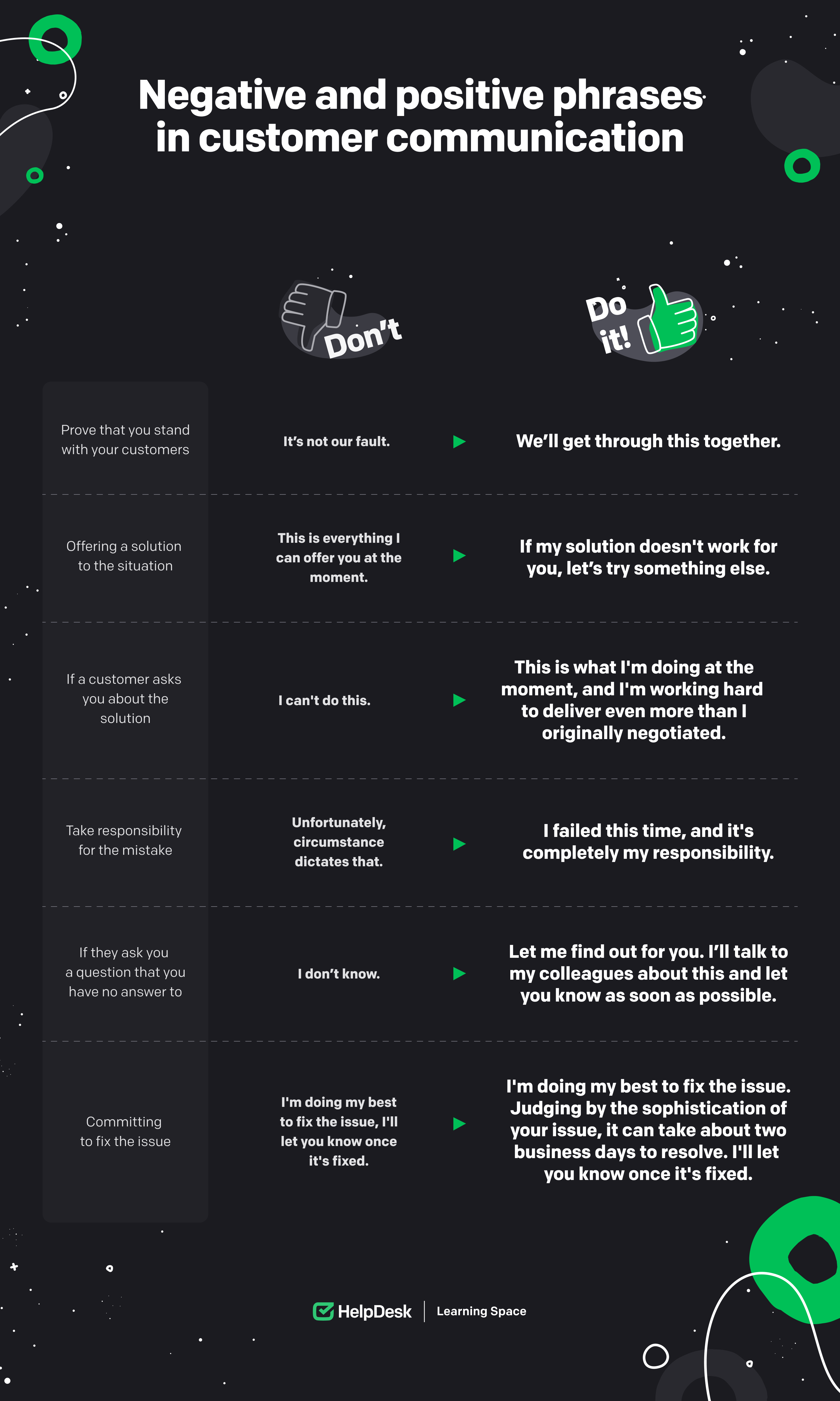


Busy supporting customers? Not anymore.
Watch hands-on webinar on workflows and easily automate your work in just five minutes!
I don’t need to tell you how important customers are for you. Their satisfaction is key to moving forward and growing your business, but life is full of surprises. Things get broken, services don’t always go as expected, deliveries get delayed, orders arrive incomplete, and front-line employees who have direct contact with customers can have a tough day and clearly show it.
Put theory into practice in difficult situations. Use soft communication skills, and try to turn an upset customer into a happy one. Learn how to deal with angry customers and how to cool down emotions to fix the customer relationship.
The situations that serve as a source of the “bad news” differ depending on variables associated with your business. The industry you operate in, your target audience, whether you provide a product or a service, and whether it’s a B2B or B2C market are just a few of those variables.
In this part, Anastasia from NetHunt CRM will touch upon a few situations that can evoke negative emotions in customers, offering tips on how to communicate through them favorably.
 I know very well how difficult dealing with customers can be. Each of them has a different disposition or mood, and I always try to sense that before interacting with them. Knowing the customer and their possible reactions are essential, especially in difficult situations. This will help you develop appropriate policies and strategies to prevent future hassles.
I know very well how difficult dealing with customers can be. Each of them has a different disposition or mood, and I always try to sense that before interacting with them. Knowing the customer and their possible reactions are essential, especially in difficult situations. This will help you develop appropriate policies and strategies to prevent future hassles.
First, find out which customer situations can be difficult. Based on my experience, I created a short, non-exhaustive list of situations that can make customers unhappy:
A price increase for products or services
Missed deadlines for product or service delivery
Product downtime, when customers are unable to use it
Refusal for future support of certain product features
Software bugs
Exceeding the project budget
Refusal to scope out feature requests
Event cancellations
And tons of more specific issues related to your brand or industry
Even companies with the best products and services have occasional run-ins with angry and disappointed customers. Now, let’s learn how to tell bad news to customers in a diplomatic and polite manner to successfully close the customer case.
Join the list and get a guide!
Subscribe now and get your awesome Business Email Writing guide.
It would be naive to assume you can run a business without coming up against a problem that impacts a customer’s perception. This isn’t a sprint. It’s a cross-country marathon with hurdles. Tool up and arm yourselves with a plan that already accounts for the odd bit of bad news. There’s no situation bad enough that the correct communication can’t solve.
Once you identify a downside to your product, like a bug that can influence a customer’s productivity, be open and message customers.
As a Head of Customer Success at NetHunt CRM, I want to emphasize that giving customers bad news should not be a complete surprise. Some of our mistakes or incidents can negatively influence their business. As soon as I understand that there’s a risk to any situation, I communicate early and warn customers about the possible consequences.
This is what I mean when I say you should be proactive. Don’t wait for customers to find the issue themselves, or worse, learn about it from a third-party resource. Let them know that you’re aware of the problem and that a fix is on the way.
Some companies tend to try and soften bad news and save face by withholding all the details. When delivering bad news, don’t be vague and don’t hide any facts. Describe the issue in detail so there’s no room left for questions or guesswork. At the end of your conversation, describe the measures you’ve taken for the same situation not to happen in the future. Customers are bound to be willing to work further with you in the future if you tell them the truth rather than sugarcoating the problem.
Provide an action plan for how and when you’re going to solve an issue. If there’s an opportunity to provide a workaround, mention it. If it’s an account-specific problem, offer a call to the customer. Learning about the problem over the phone, rather than via email, adds personality and credibility. This helps customers understand they’re valued and not left to their own fate.
It’s more than likely customers will ask you different questions about the issue. Your job here is to provide answers as soon as possible, helping customers understand that you’re in control. To this end, put yourself in your customer’s shoes as you craft your news message. Ask yourself the questions they could have. Do your research and prepare answers to those questions.
Never blame the customer. This doesn’t mean to simply submit yourself, but rather to admit that there’s a problem and outline a way out of it. To the same end, don’t blame your partners, suppliers, or developers. Customers need to see a brand that’s responsible for its own outcomes.
It’d be wrong to have an initial conversation and fall silent afterward. Write a follow-up email a day or two later, stating the progress you’ve made with the problem. Send the date when you think you’re going to solve the issue. If you don’t know the exact date you’ll deliver the fix, at least state the date of the next update you’ll send to the customers.
Similarly, ask how the customers are dealing with an issue and whether you can help them somehow. Make them feel like your top priority.

No matter how angry customers are, how offensive they sound, or how terribly they describe your company, the situation, or you, don’t lose focus. You have to be stoic, friendly, and aimed at solving the problem rather than argumentative.
When the customer raises their voice, don’t raise yours. Looking through their eyes, they have the right to be mad. Only by having a clear mind and staying emotionally detached you can conduct a constructive dialogue.
Still, show empathy and make customers realize that you know how they feel. Based on my experience, I’ve compiled samples of email lines you can use when responding to an unhappy customer. Find out what to say and avoid when communicating with customers. Check out the tone of voice that is recommended when responding to an upset customer and try it in your customer support actions.
 Communicating properly during a crisis can make or break your business, directly influencing brand reputation. Demonstrate unity by collaborating with your customers, never hide from them, and over-perform to save your relationship. Hopefully, the tips from this lesson help you come through any problem you face. Like I said, in business, these problems are inevitable.
Communicating properly during a crisis can make or break your business, directly influencing brand reputation. Demonstrate unity by collaborating with your customers, never hide from them, and over-perform to save your relationship. Hopefully, the tips from this lesson help you come through any problem you face. Like I said, in business, these problems are inevitable.
Keep all your customer communication in one place. Sign up to HelpDesk for a free 14-day trial to deliver outstanding customer support every day.
Making your customers’ day is always something to look forward to, but sometimes you need to deliver uncompromising news to your loyalists.
So, how would you handle an angry customer or deliver bad news to them? Your success in such situations lies in the way you communicate. If done effectively, you’ll win back your customers’ trust and loyalty.
Beatriz Estay from BigCommerce has put together a four-step action plan for you to handle an angry customer easily and effectively.
 When a customer complains about your product or service and communication becomes uneasy, you need to be prepared. Replace spontaneity with a well-thought-out plan for confronting the customer so that each side is satisfied with the interaction. Now, let’s break down the four-step action plan to communicate tough news to your customers.
When a customer complains about your product or service and communication becomes uneasy, you need to be prepared. Replace spontaneity with a well-thought-out plan for confronting the customer so that each side is satisfied with the interaction. Now, let’s break down the four-step action plan to communicate tough news to your customers.
The bad news is always a sensitive topic. You’ll need to be the bearer of bad news when, for example:
Canceling a customer’s order.
Not being able to accept a return or offer a cash refund due to company policy.
When you need to address an issue at the brand level (e.g., crisis management).
And many more unpleasant and well-known situations.
Create a clear and concise message that directly explains the issue at hand, and be sure to add a personal touch. By personalizing the message, customers know they’re valued and that your business has the best intention of resolving the issue.
This is your opportunity to win back your customer. In addressing the issue, offer a solution or promise to do better in the future. For example, if you’ve canceled a customer’s order, consider offering a special discount code to try another product in the future. A special approach to the customer can reduce the feeling of missing out on a great opportunity. It also encourages the customer to continue investing time and energy in building the relationship.
Let your customers know that you’re listening and willing to take the actionable steps to improve their experience. Engaging in dialogue will help you learn more about moving forward and providing your customers the opportunity to contribute to the greater brand community.
Personally follow-up with your customers to hold your team accountable and ensure your customers’ satisfaction. The additional effort won’t go unnoticed. Plan some proven follow-up messages, so you don’t have to make them up on the fly.

Creating exceptional experiences through customer communication is something more and more companies strive for. It’s not always easy. Sometimes a difficult situation forces us to deliver bad news. However, it only takes a few well-chosen words to show the customer that they’re always our top priority and that we care about their happiness at all times. Let’s recap everything I’ve said in this lesson in a few points:
When giving the bad news, be proactive, clear, provide the solution, think bigger, take responsibility, and follow up on the progress.
Identify the words that make a customer happy. Create a list of negative and positive phrases in your customer communications and share it with your customer service agents, so you all use the exact wording and avoid language traps.
Create your backup plan in case of an unhappy customer. You can use our four-step action plan, but we encourage you to expand it according to your needs. Every business is different and should approach this issue individually.
Find the best answers you’ve used in the past when dealing with an angry customer and turn that part of your conversations into canned responses. Be prepared to deal with a variety of people and always have the right answer on hand.
In the next lesson
How To Get Customer Feedback and Measure Satisfaction
In the next lesson, you'll learn about customer complaint management strategies. Complaints are useful for your business, and you will learn how to handle them and still keep morale high. Finally, I'll give you some tips on not losing a support case and closing each case as resolved and successful.
Go to lesson 6Subscription with a gift!
Join the mailing list to get a special ebook on email communication.
Try HelpDesk for free
For quick and intuitive tickets management